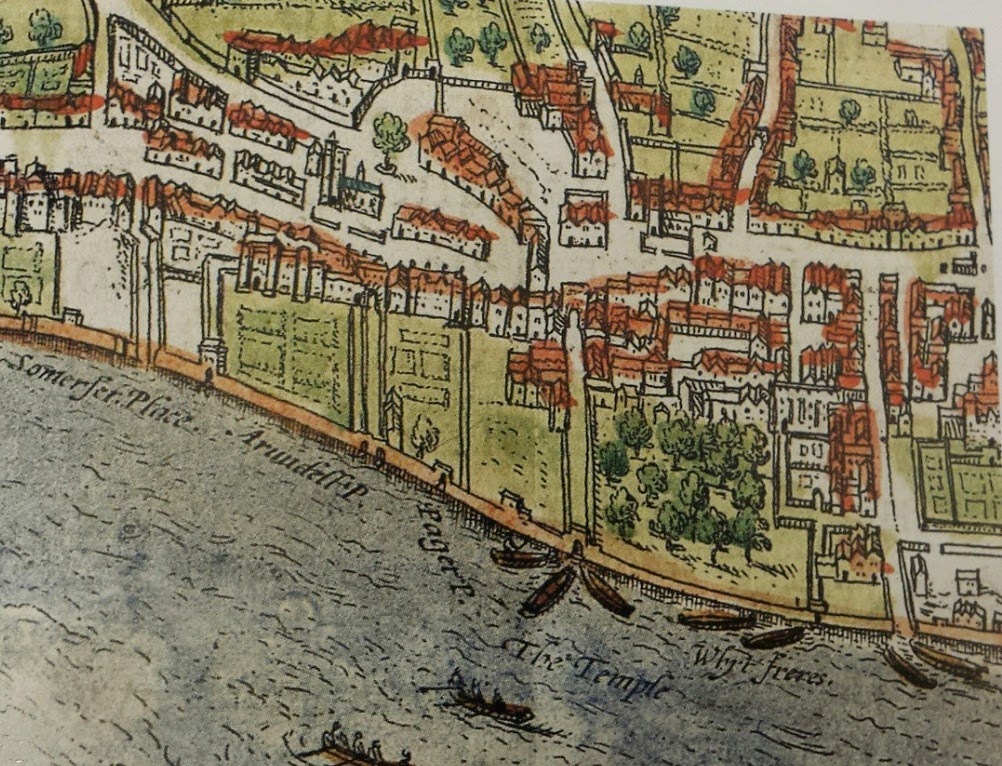 |
| Nicholas Hilliard, Robert Dudley, Earl of Leicester , watercolour on vellum (1576) National Portrait Gallery |
Robert Dudley, Earl of Leicester is perhaps one of the most famous of Queen Elizabeth's courtiers . This is mostly because of his imitate relationship with the queen throughout her reign. As I know little of Elizabethan history I won't speculate too closely on the relationship between the two, but Elizabeth is understood to have given Leicester hopes of a potential marriage and his secret marriage to Lettice, Countess of Dowager in 1578 caused scandal. It also had a dramatic effect upon Leicester's relationship with the queen. As juicy as all this, my focus is not on the in's and out's of this turbulent relationship, but instead about the site of Leicester's London residence which many of you may unknowingly pass during your London wanderings.
 |
Attributed to Marcus Gheeraerts, Queen Elizabeth dancing la volta with Robert Dudley, Earl of Leicester, c.1580 Penhurst Palace, Kent
|
As a nobleman and courtier. Leicester required regular access to the city of London, Westminster and of course, the royal palaces situated on the outskirts of London in Greenwich, Richmond and Hampton Court. Dudley therefore was the owner of three properties. Kenliworth Castle, Wanstead Manor and in 1570, Paget Place, which was quickly renamed, Leicester House for obvious reasons.
 |
| The boundary marking entry to the City of London on the embankment |
Leicester House was situated between the City of London and Westminster, on the Strand opposite Sir Christopher Wren's chuch, St Clement Danes, which still stands today.
 |
| The site of Robert Dudley, Earl of Leicester's residence, Leicester House |
The boundaries of Leicester House lie between the George pub and Milford Lane. Essex Street was introduced in the late seventeenth century and runs directly through what was Leicester's garden. A view of Leicester's garden is visible in a map dating from 1572. The map illustrates a neat knotted garden which led down from the house towards the Thames. It was common for Thames side mansions to have their principle entrances on the river front because important guests were more likely to travel by boat rather than road. This map shows detail of a path running alongside the north bank which provided access into the mansions.
Historian Elizabeth Goldring's recent publication Robert Dudley, Earl of Leicester and the World of Elizabethan Art provides a detailed insight into Leicester's extensive art collection including commissioned pieces by Nicholas Hilliard, Paolo Veronese and Federico Zucarro. This book helps to build an understanding of how Leicester House was furnished and the status of the works displayed.
Goldring's study also discusses the relationship between Leicester House and Dudley's suburban residence Wanstead Manor, which likewise has been lost. According to Leicester, it was possible to leave London in the morning to visit Wanstead and be back at Leicester House that night. This highlights the benefits of owning a suburban residence. By riding to Wanstead, Leicester could retreat from his busy urban life whilst maintaining links with the city and returning easily when necessary.
Although the physical structure of Leicester House has vanished we can still gain a historical understanding of how the house appeared by tracing the objects which were once displayed there and by considering the effects of the ownership of such a property had upon status. This helps us to see through the layers of London that have since developed and begin to imagine how the site of Leicester House appeared and was experienced for someone like Robert Dudley, Earl of Leicester.
Further Reading:
E. Goldring, Robert Dudley, Earl of Leicester and the World of Elizabethan Art, (London and New Haven: Yale University Press, 2014).
S. Adams, Household Accounts and Disbursement Books of Robert Dudley, Earl of Leicester, (Cambridge: Cambridge University Press, 1996).
S.Adams, (1532/3–1588)’, Oxford Dictionary of National Biography, Oxford University Press, 2004; online edn, May 2008 [http://www.oxforddnb.com/view/article/8160, accessed 11 May 2015]


